Etat des lieux de l'homéopathie en Belgique - KCE
Etat des lieux de l'homéopathie en Belgique - KCE
Etat des lieux de l'homéopathie en Belgique - KCE
You also want an ePaper? Increase the reach of your titles
YUMPU automatically turns print PDFs into web optimized ePapers that Google loves.
56 Homeopathy <strong>KCE</strong> Reports 154<br />
4.3.10 Type of medicines used and type of homeopathy practiced.<br />
Medicines with korsakovian method of manufacture (multi-flask method here <strong>de</strong>noted<br />
as K) are more oft<strong>en</strong> prescribed (91,7%) than medicines with hahnemanian method of<br />
manufacture (single-flask method, here <strong>de</strong>noted as CH) (69,4%).<br />
Low or middle dilutions are more oft<strong>en</strong> prescribed than high or very high dilutions.<br />
Table 12: Dilutions used (expressed as CH) (n=144)<br />
%<br />
Low dilutions (12CH) 37,0%<br />
Therapists use a variety of homeopathic approaches: ‘classicist–unicist’ homeopaths are<br />
loyal to Hahnemann’s teachings and seek a single remedy tailored to each individual<br />
pati<strong>en</strong>t. They repres<strong>en</strong>t the great majority of homeopaths affiliated with a professional<br />
association (see next table). ‘Complex–pluralist’ homeopaths prescribe a combination of<br />
‘contextual’ and ‘fundam<strong>en</strong>tal’ remedies. Finally, clinical homeopaths favour the use of<br />
homeopathic remedies <strong><strong>de</strong>s</strong>igned to act on a specific organ or system. These remedies<br />
may or may not be <strong>de</strong>livered in complex form and usually in low dilution.<br />
Table 13: Type of homeopathy practices (n=144)<br />
All UHB LIGA<br />
Frequ<strong>en</strong>cy % Frequ<strong>en</strong>cy % Frequ<strong>en</strong>cy %<br />
No answer 3 2 1<br />
Classic/unicist 108 75,0% 80 69,6% 36 92,3%<br />
Complex 19 13,2% 19 16,5% 1 2,6%<br />
Clinical 29 20,1% 28 24,3% 1 2,6%<br />
Others 5 3,5% 4 3,5% 2 5,1%<br />
4.4 DISCUSSION<br />
This survey gives a <strong><strong>de</strong>s</strong>cription of the profile of homeopaths that are affiliated to a<br />
professional organisation, as stated in the objective. We have no information about non<br />
affiliated practitioners, which is a major limitation as affiliated members probably only<br />
repres<strong>en</strong>t 10 % of the practitioners, their profile may be differ<strong>en</strong>t as those professional<br />
organisations have a number of requirem<strong>en</strong>ts concerning training and practice and there<br />
may be consi<strong>de</strong>rable differ<strong>en</strong>ces in attitu<strong>de</strong>, <strong>de</strong>gree and way homeopathy is used<br />
amongst them. Another major limitation was the fact that the professional organisations<br />
c<strong>en</strong>sored our questionnaire and refused questions about use and attitu<strong>de</strong> towards<br />
vaccination, we know from our in <strong>de</strong>pth interviews that there is resistance towards<br />
vaccination among practitioners, but due to this refusal we do not have more<br />
information on this problem. Surveys in Germany, Austria, Australia and the USA<br />
docum<strong>en</strong>ted resistance against vaccination in similar surveys 73, 74 .This also implies that<br />
the survey should be rather se<strong>en</strong> as a <strong><strong>de</strong>s</strong>cription of what the professional organisations<br />
choose to reveal about their profile. Response rate was good compared with other<br />
similar surveys, but was lower for the UHP. According to stakehol<strong>de</strong>rs from the UHP<br />
this would still be a consequ<strong>en</strong>ce or resistance towards the remaining questions. We<br />
could find very few differ<strong>en</strong>ces betwe<strong>en</strong> practitioners from both professional<br />
organisations.

















